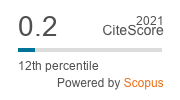Signos radiológicos en la neuroimagen de pacientes pediátricos con trastorno por estrés postraumático
Resumen
Objetivo: Describir los signos radiológicos en la neuroimagen de pacientes pediátricos con estrés postraumático.
Desarrollo: Los estudios de neuroimagen en niños y adolescentes con trastorno por estrés postraumático se han centrado en estructuras anormales y la funcionalidad de algunas regiones individuales del cerebro; estas implican las regiones cerebrales asociadas con la fisiopatología, ellas son: la corteza prefrontal medial y dorsolateral; la corteza orbitofrontal; ínsula; núcleo lentiforme; amígdala; hipocampo y el parahipocampo; la corteza cingulada anterior y posterior; el precúneo; cúneo; el giro fusiforme y lingual y los tractos de materia blanca que conectan estas regiones cerebrales.
Conclusiones: Los signos radiológicos en la neuroimagen de pacientes pediátricos con trastorno por estrés postraumático son: reducción de los volúmenes del hipocampo; del volumen cerebral e intracraneal y del volumen de la amígdala, así como una disminución del área total del cuerpo calloso. Además se observa que el volumen hipofisario y los volúmenes de materia gris cerebral fueron menores en los pacientes con estrés postraumático.
Palabras clave
Referencias
Cordova MJ, Riba MB, Spiegel D. Post-traumatic stress disorder and cancer. Lancet Psychiatry. 2017; 4(4): 330-8. DOI: 10.1016/S2215-0366(17)30014-7
Pérez Benítez CI, Vicente B, Zlotnick C, Kohn R, Johnson J, Valdivia S, et al. Estudio epidemiológico de sucesos traumáticos, trastorno de estrés postraumático y otros trastornos psiquiátricos en una muestra representativa de Chile. Salud Ment (Mex). 2009 [acceso: 02/05/21]; 32(2):145-53. Disponible: https://www.ncbi.nlm.nih.gov/pmc/articles/PMC2990643
Fariba K, Gupta V. Posttraumatic Stress Disorder In Children. 2021[acceso: 02/05/2021]. Disponible en: https://www.ncbi.nlm.nih.gov/books/NBK559140/
Haravuori H, Kiviruusu O, Suomalainen L, Marttunen M. An evaluation of ICD-11 posttraumatic stress disorder criteria in two samples of adolescents and young adults exposed to mass shootings: factor analysis and comparisons to ICD-10 and DSM-IV. BMC Psychiatry. 2016 [acceso: 02/05/2021];16: 140. Disponible en: https://bmcpsychiatry.biomedcentral.com/articles/10.1186/s12888-016-0849-y
Milani AC, Hoffmann EV, Fossaluza V, Jackowski AP, Mello MF. Does pediatric post-traumatic stress disorder alter the brain? Systematic review and metaanalysis of structural and functional magnetic resonance imaging studies. Psychiatry Clin Neurosci. 2017; 71(3):154-69. DOI: 10.1111/pcn.12473
Marquez ER, Esquerdo JM, Pérez-Villamil ÁH. Aproximación al estudio psicopatológico del TEPT a través de las técnicas de neuroimagen. Psiquiatria.Com, Trabajos; 2009 [acceso: 02/05/2021]. Disponible en: https://psiquiatria.com/trabajos/usr_6668810106519.pdf
Moyer A. Post-traumatic Stress Disorder and Magnetic Resonance Imaging. Radiol Technol. 2016 [acceso: 02/05/2021]; 87(6):649-67. Disponible en: http://www.radiologictechnology.org/cgi/pmidlookup?view=long&pmid=27390232
Szeszko PR, Yehuda R. Magnetic resonance imaging predictors of psychotherapy treatment response in post-traumatic stress disorder: A role for the salience network. Psychiatry Res. 2019 [acceso: 02/05/2021]; 277:52-57 Disponible en: https://www.sciencedirect.com/science/article/abs/pii/S0165178118322297?-via%3Dihub
Kamiya K, Abe O. Imaging of Posttraumatic Stress Disorder. Neuroimaging Clin N Am. 2020; 30(1): 115-23. DOI: 10.1016/j.nic.2019.09.010
Zandvakili A, Swearingen HR, Philip NS. Changes in functional connectivity after theta-burst transcranial magnetic stimulation for post-traumatic stress disorder: a machine-learning study. Eur Arch Psychiatry Clin Neurosci. 2021; 271(1): 29-37. DOI: 10.1007/s00406-020-01172-5
Cwik JC, Vahle N, Woud ML, Potthoff D, Kessler H, Sartory G, Seitz RJ. Reduced gray matter volume in the left prefrontal, occipital, and temporal regions as predictors for posttraumatic stress disorder: a voxel-based morphometric study. Eur Arch Psychiatry Clin Neurosci. 2020; 270(5): 577-88. DOI: 10.1007/s00406-019-01011-2
Morey RA, Haswell CC, Hooper SR, De Bellis MD. Amygdala, Hippocampus, and Ventral Medial Prefrontal Cortex Volumes Differ in Maltreated Youth with and without Chronic Posttraumatic Stress Disorder. Neuropsychopharmacology. 2016; 41(3): 791-801. DOI: 10.1038/npp.2015.205
De Bellis MD, Hooper SR, Chen SD, Provenzale JM, Boyd BD, Glessner CE, et al. Posterior structural brain volumes differ in maltreated youth with and without chronic posttraumatic stress disorder. Dev Psychopathol. 2015; 27(4Pt2): 1555-76. DOI: 10.1017/S0954579415000942org
Cunha PJ, Duran FLS, de Oliveira PA, Chaim-Avancini TM, Milioni ALV, Ometto M, et al. Callosal abnormalities, altered cortisol levels, and neurocognitive deficits associated with early maltreatment among adolescents: A voxel-based diffusion tensor imaging study. Brain Behav. 2021; 11(3): e02009. DOI:10.1002/brb3.2009
Liu T, Ke J, Qi R, Zhang L, Zhang Z, Xu Q, et al. Altered functional connectivity of the amygdala and its subregions in typhoon-related posttraumatic stress disorder. Brain Behav. 2021; 11(1): e01952. DOI: 10.1002/brb3.1952
Kribakaran S, Danese A, Bromis K, Kempton MJ, Gee DG. Meta-analysis of Structural Magnetic Resonance Imaging Studies in Pediatric Posttraumatic Stress Disorder and Comparison With Related Conditions. Biol Psychiatry Cogn Neurosci Neuroimaging. 2020; 5(1):23-34. DOI: 10.1016/j.bpsc.2019.08.006
Bromis K, Calem M, Reinders AATS, Williams SCR, Kempton MJ. Meta-Analysis of 89 Structural MRI Studies in Posttraumatic Stress Disorder and Comparison With Major Depressive Disorder. Am J Psychiatry. 2018; 175(10): 989-98. DOI: 10.1176/a ppi.ajp.2018.17111199
Weems CF, Russell JD. Variation in the Developing Brain and the Role of Pediatric Posttraumatic Stress on Structural and Functional Networks. Biol Psychiatry Cogn Neurosci Neuroimaging. 2020; 5(1): 7-9. DOI: 10.1016/j.bpsc.2019.10.003
Sun D, Haswell CC, Morey RA, De Bellis MD. Brain structural covariance network centrality in maltreated youth with PTSD and in maltreated youth resilient to PTSD. Dev Psychopathol. 2019; 31(2): 557-71. DOI: 10.1016/S2215-0366(17)30014-7
Suo X, Lei D, Li K, Chen F, Li F, Li L, et al. Disrupted brain network topology in pediatric posttraumatic stress disorder: A resting-state fMRI study. Hum Brain Mapp. 2015; 36(9): 3677-86. DOI: 10.1002/hbm.22871
Suo X, Lei D, Chen F, Wu M, Li L, Sun L, et al.Anatomic Insights into Disrupted Small-World Networks in Pediatric Posttraumatic Stress Disorder. Radiology .2017 ; 282(3):826-834. DOI: 10.1148/radiol.2016160907
Li M, Wu J, Jiang P, Yang S, Guo R, Yang Y, et al. Corpus Callosum Diffusion Anisotropy and Hemispheric Lateralization of Language in Patients with Brain Arteriovenous Malformations. Brain Connect. 2021. DOI:10.1089/brain.2020.0853
Kunimatsu A, Yasaka K, Akai H, Natsuko Kunimatsu, Osamu A.MRI Findings in Posttraumatic Stress Disorder. J Magn Reson Imaging. 2020; 52(2):380-396. DOI: 10.1002/jmri.26929
Morey RA CC, De Bellis MD. Brain structural covariance network centrality in maltreated youth with PTSD and in maltreated youth resilient to PTSD. Dev Psychopathol. 2019; 31(2):557-71. DOI: 10.1016/S2215-0366(17)30014-7
Li L, Pan N, Zhang L, Lui S, Huang X, Xu X, et al. Hippocampal subfield alterations in pediatric patients with post-traumatic stress disorder. Soc Cogn Affect Neurosci. 2021; 16(3):334-44. DOI: 10.1093/scan/nsaa162
Enlaces refback
- No hay ningún enlace refback.
URL de la licencia: https://creativecommons.org/licenses/by-nc-sa/4.0/deed.es





 La revista es de acceso abierto y gratuito.
La revista es de acceso abierto y gratuito.